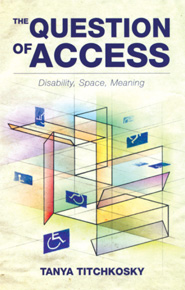Disability, Space, Meaning

Tanya Titchkosky. Toronto, ON: University of Toronto Press, 2011; 192 pp; ISBN: 978-1-44264-026-9, cloth $55 CAD.
Reviewed by Nancy Hansen
Tanya Titchkosky’s fine new book is stimulating and worthy of note. In The Question of Access she takes the reader on a refreshingly forthright journey through the physical and temporal landscape of the modern university. She examines how disability and impairment is understood (or not), within the academy. In the process the author turns the traditional, individualized, medicalized, problematic, understandings of disability and impairment on their head.
In six chapters Titchkosky, a disabled academic, questions the way in which the underlying philosophy of the academy determines how academic space is organized and prioritized for some and not for others. Similarly, how support is provided for some and not for others.
The author maintains that practices do not evolve in a vacuum and the perception of disability is culturally imbued. Consequently, how disability is understood has a direct impact on how it is framed and addressed. Disability is rarely conceived as a shared, regular or natural part of public space but rather a social anomaly.
The unexpectedness of disability in academic space is a reflection in the taken-for-granted absences or rather its unimagined presence in the first place. Disability or impairment is not perceived as a natural fit in this space. Where disability is present in the academy it is largely presented as a private student concern. Disabled academic staff are often virtually absent from the cultural mindset.
This approach works to reproduce the privilege and power and value of the normal — however that is constructed — while further diminishing that of disability. Often perceived as a worst case scenario, the presence of disability in the academic setting is commonly characterized as unnatural or disruptive to the natural, established processes of academic space.
The personal costs to the individual involved in self-identification often weigh heavily. An essentialist approach to disability often reduces people to their conditions. A binary all-or-nothing understanding of disability draws a sharp line between who belongs in certain spaces and who does not. The dominance of the reductionism is further illustrated by a bureaucratic/legalistic approach to equity void of imagination and mired in forms and cost-benefit relations. The energy of administration is spent counting, meeting and planning as opposed to doing. Caught up in waiting for the right time or space quantitative elements remain paramount.
Surveys and questionnaires are endlessly repeated. These document the planning for progress and thereby maintain the status quo. Historical absences remain intact or at least minimally displaced. Titchkosky wonders whether such practices are exclusive or exclusionary, further objectifying the other.
She further relates how the university landscape often presents symbols of access (most commonly, the blue and white wheelchair images), as representing the possibility or concept of access rather than the substantive reality. A strange dualism of inaccessible/accessibility is seemingly ever-present, mitigated by a better than nothing philosophy. This is best illustrated when access is absent or wheelchair access signs are placed on inaccessible washroom doors.
Access remains contingent when the absence of disability is normalized and when disability is characterized as problematic rather than ordinary. People with disabilities are regularly expected to make do with physical accommodations that even with the best intentions may not work, or options that are very difficult and not fully thought through.
The author maintains that disability issues are not truly present because they are rarely included in the dominant diversity discourse. Marginal accessibility reflects the understanding that the use of space is not yet universal and certain groups remain naturally, socially excluded or at best periodically included.
Titchkosky argues that in order for disability to move beyond a tentative presence in the academy its historical absence and dislocation must be questioned from the outset. What is known and understood about disability compels critical re-examination. Spaces of knowledge are slowly changing driven by rethinking the margins. People with disabilities are active agents in this process.
The author believes that in much the same manner as women’s and native studies, disability studies is questioning what is natural and who belongs, challenging the comfort of long-established beliefs. The discipline is helping to create spaces for and means of dialogue. A textured understanding of disability is emerging. Interpretations are changing and disability is being rethought.
Through narratives of struggle and analyses of policy and everyday practices, The Question of Access presents a thoughtful, important perspective. The book is a much-needed resource with which to generate further discussion and positive change in and outside of the academy.
---------------------------------------------------------------
Nancy E. Hansen is director of the interdisciplinary master’s program in disability studies at the University of Manitoba and a member of CAUT’s academic staff with disabilities working group.